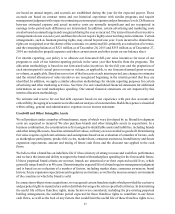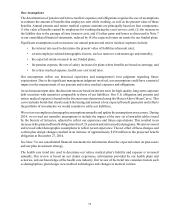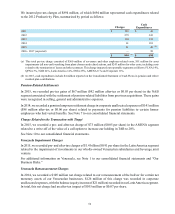Pepsi 2015 Annual Report Download - page 65
Download and view the complete annual report
Please find page 65 of the 2015 Pepsi annual report below. You can navigate through the pages in the report by either clicking on the pages listed below, or by using the keyword search tool below to find specific information within the annual report.
Table of Contents
48
including legal, regulatory, contractual, competitive, economic or other factors. Therefore, certain of these
franchise rights are considered as indefinite-lived, with the balance amortized over the remaining contractual
period of the contract in which the right was granted.
Indefinite-lived intangible assets and goodwill are not amortized and are assessed for impairment at least
annually, using either a qualitative or quantitative approach. We perform this annual assessment during our
third quarter. Where we use the qualitative assessment, first we determine if, based on qualitative factors, it
is more likely than not that an impairment exists. Factors considered include macroeconomic, industry and
competitive conditions, legal and regulatory environment, historical financial performance and significant
changes in the brand or reporting unit. If the qualitative assessment indicates that it is more likely than not
that an impairment exists, then a quantitative assessment is performed.
The quantitative assessment requires an analysis of several estimates including future cash flows or income
consistent with management’s strategic business plans, annual sales growth rates, perpetuity growth
assumptions and the selection of assumptions underlying a discount rate (weighted-average cost of capital)
based on market data available at the time. Significant management judgment is necessary to estimate the
impact of competitive operating, macroeconomic and other factors to estimate future levels of sales, operating
profit or cash flows. All assumptions used in our impairment evaluations for nonamortizable intangible assets,
such as forecasted growth rates and weighted-average cost of capital, are based on the best available market
information and are consistent with our internal forecasts and operating plans. These assumptions could be
adversely impacted by certain of the risks described in “Item 1A. Risk Factors” and “Our Business Risks.”
See Note 2 to our consolidated financial statements for additional information on performing the quantitative
assessment.
Amortizable intangible assets are only evaluated for impairment upon a significant change in the operating
or macroeconomic environment. If an evaluation of the undiscounted future cash flows indicates impairment,
the asset is written down to its estimated fair value, which is based on its discounted future cash flows.
We did not recognize any impairment charges for goodwill in each of the fiscal years ended December 26,
2015, December 27, 2014 and December 28, 2013. In 2015, we performed the impairment analysis for
goodwill for certain of our reporting units and for certain of our indefinite-lived intangible assets using the
qualitative approach and concluded that it was more likely than not that the estimated fair values of our
reporting units or our indefinite-lived intangible assets were greater than their carrying amounts. After
reaching this conclusion, no further testing was performed.
We recognized no material impairment charges for nonamortizable intangible assets in each of the fiscal
years ended December 26, 2015, December 27, 2014 and December 28, 2013. In 2014, we recognized pre-
tax impairment charges in ESSA for nonamortizable intangible assets of $23 million. As of December 26,
2015, the estimated fair values of our indefinite-lived reacquired and acquired franchise rights recorded at
NAB exceeded their carrying values. However, there could be an impairment of the carrying value of NAB’s
reacquired and acquired franchise rights if future revenues and their contribution to the operating results of
NAB’s CSD business do not achieve our expected estimated future cash flows or if macroeconomic conditions
result in a future increase in the weighted-average cost of capital used to estimate fair value. We have also
analyzed the impact of the recent economic and political developments in Russia on the estimated fair value
of our indefinite-lived intangible assets in Russia and have concluded that there is no impairment as of
December 26, 2015. However, a further deterioration in these conditions in Russia could potentially require
us to record an impairment charge for these assets in the future.
























